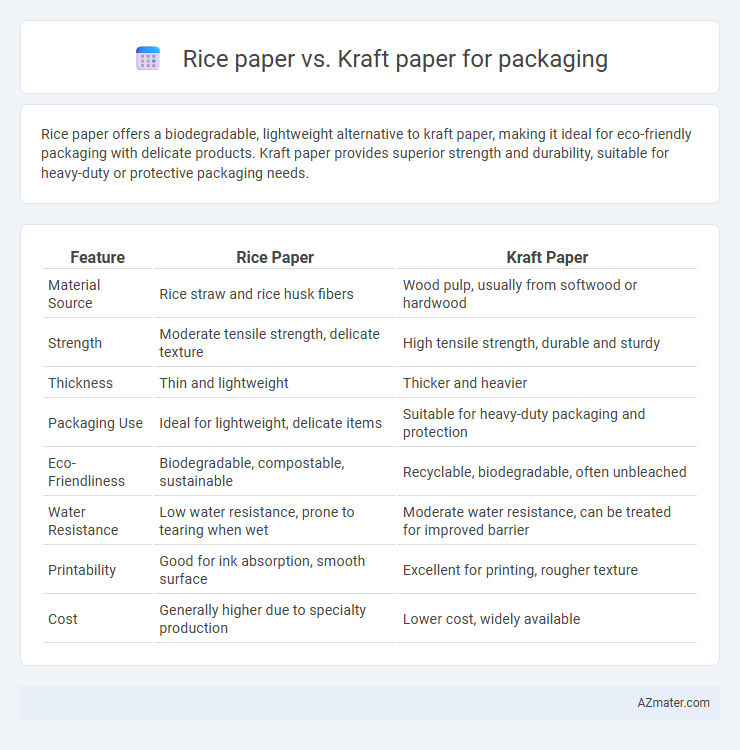Rice paper offers a biodegradable, lightweight alternative to kraft paper, making it ideal for eco-friendly packaging with delicate products. Kraft paper provides superior strength and durability, suitable for heavy-duty or protective packaging needs.
Table of Comparison
| Feature | Rice Paper | Kraft Paper |
|---|---|---|
| Material Source | Rice straw and rice husk fibers | Wood pulp, usually from softwood or hardwood |
| Strength | Moderate tensile strength, delicate texture | High tensile strength, durable and sturdy |
| Thickness | Thin and lightweight | Thicker and heavier |
| Packaging Use | Ideal for lightweight, delicate items | Suitable for heavy-duty packaging and protection |
| Eco-Friendliness | Biodegradable, compostable, sustainable | Recyclable, biodegradable, often unbleached |
| Water Resistance | Low water resistance, prone to tearing when wet | Moderate water resistance, can be treated for improved barrier |
| Printability | Good for ink absorption, smooth surface | Excellent for printing, rougher texture |
| Cost | Generally higher due to specialty production | Lower cost, widely available |
Introduction to Rice Paper and Kraft Paper Packaging
Rice paper packaging is crafted from natural rice straw fibers, offering biodegradable and eco-friendly properties perfect for sustainable product wrapping. Kraft paper, made from chemical pulp treated wood fibers, provides high durability and tear resistance for robust packaging needs. Both materials serve crucial roles in balancing environmental impact and packaging strength across various industries.
Material Composition: Rice Paper vs Kraft Paper
Rice paper, derived from natural fibers such as rice straw, bamboo, and hemp, offers a lightweight and biodegradable option with a delicate texture suitable for eco-conscious packaging. Kraft paper is made from wood pulp processed through the kraft process, resulting in a strong, durable, and tear-resistant material ideal for heavy-duty packaging needs. The cellulose content in rice paper is relatively lower, providing flexibility and translucency, whereas kraft paper's high lignin content contributes to its robustness and brown hue.
Environmental Impact and Sustainability
Rice paper, derived from natural plant fibers like rice straw, offers a biodegradable and compostable packaging option with low environmental impact due to its renewable sourcing and minimal processing emissions. Kraft paper, made from wood pulp through a chemical kraft process, provides durability but has a higher carbon footprint and deforestation concerns unless sourced from certified sustainable forests. Choosing rice paper enhances sustainability through reduced waste and renewable materials, while kraft paper requires responsible sourcing and recycling to mitigate environmental effects.
Strength and Durability Comparison
Rice paper, made from natural fibers like rice straw, offers lightweight packaging but has limited strength and durability, making it less suitable for heavy or moisture-sensitive products. Kraft paper, produced from wood pulp through the kraft process, provides superior tensile strength, tear resistance, and moisture barrier properties, ensuring robust protection during shipping and handling. For packaging applications requiring high durability and strength, kraft paper is the preferred choice due to its enhanced resilience and versatility.
Visual Appeal and Printing Capabilities
Rice paper offers a smooth, delicate texture that enhances the visual appeal of packaging with its subtle translucency and natural off-white tone, making it ideal for luxury and artisanal products. Kraft paper provides a rustic, earthy aesthetic with a sturdy, coarse surface that supports bold, vibrant printing and clear branding elements, perfect for eco-friendly and heavy-duty packaging. Both materials accommodate various printing techniques, but rice paper excels in fine detail reproduction, while kraft paper handles large graphics and high-contrast designs more effectively.
Moisture and Barrier Properties
Rice paper offers moderate moisture resistance due to its natural composition but lacks strong barrier properties, making it less suitable for packaging items requiring high moisture protection. Kraft paper provides superior moisture resistance and enhanced barrier properties, attributed to its dense fiber structure and possible coatings, ideal for packaging products needing durability and moisture control. The choice between rice paper and kraft paper depends on the packaging's specific moisture protection requirements and environmental considerations.
Cost Efficiency and Production Considerations
Rice paper offers a lightweight and biodegradable option for eco-conscious packaging but typically incurs higher material costs and slower production speeds compared to kraft paper. Kraft paper provides superior durability, is more cost-effective for large-scale manufacturing, and supports faster processing due to its strength and availability. Businesses prioritizing cost efficiency and high-volume output often prefer kraft paper, while rice paper suits niche markets valuing sustainability despite increased expenses.
Typical Packaging Applications
Rice paper is commonly used for lightweight and delicate packaging, such as wrapping luxury food items, bakery goods, and handmade crafts due to its fine texture and biodegradability. Kraft paper excels in heavy-duty packaging applications, including shipping boxes, grocery bags, and industrial wrapping because of its high tensile strength and durability. The choice between rice paper and kraft paper depends on whether the packaging requires delicate presentation or robust protection.
Consumer Perceptions and Market Trends
Rice paper packaging is increasingly favored for its eco-friendly and biodegradable qualities, appealing to environmentally conscious consumers seeking sustainable alternatives. Kraft paper remains popular for its durability and rustic aesthetic, often perceived as reliable and cost-effective for packaging everyday products. Market trends indicate a growing shift towards rice paper in premium and artisanal markets, while kraft paper continues to dominate mass-market packaging due to its versatility and lower price point.
Choosing the Best Paper for Your Packaging Needs
Rice paper offers a lightweight, biodegradable option ideal for delicate or luxury packaging, providing a smooth texture and elegant appearance. Kraft paper, known for its durability, strength, and resistance to tearing, suits heavy-duty packaging and sustainable branding efforts. Selecting the best paper hinges on balancing factors like product protection requirements, environmental impact, and desired aesthetic appeal.

Infographic: Rice paper vs Kraft paper for Packaging
 azmater.com
azmater.com